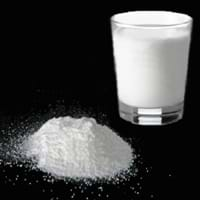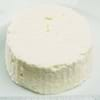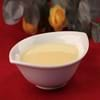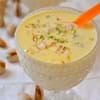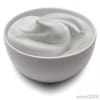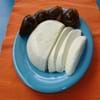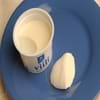Milk Powder vs Peanut Butter
Calories
Calories in 1 pat
434.00 Kcal
13
1,543.00 Kcal
25
Calories per 100g
362.00 Kcal
27
598.00 Kcal
7
Calories in 1 tbsp
17.00 Kcal
5
96.00 Kcal
16
Calories in 1 cup
Not Available
Not Available
Calories in 1 stick
Not Available
Not Available
Serving size
100
100
Proteins
36.16 g
5
22.21 g
22
Carbs
51.98 g
6
22.31 g
22
Fiber
0.00 g
15
5.00 g
2
Sugar
51.98 g
99+
10.49 g
99+
Fats
0.77 g
5
3.50 g
20
Saturated Fat
0.50 g
4
3.50 g
31
Trans Fat
Not Available
2.00 g
9
Polyunsaturated Fat
0.03 g
99+
1.00 g
20
Monounsaturated Fat
0.20 g
99+
0.25 g
99+
Nutrition
Serving Size
100
100
Cholesterol
20.00 mg
99+
2.50 mg
99+
Vitamins
Vitamin A
22.00 IU
99+
0.00 IU
99+
Vitamin B1 (Thiamin)
0.42 mg
3
0.15 mg
8
Vitamin B2 (Riboflavin)
1.55 mg
2
0.19 mg
99+
Vitamin B3 (Niacin)
0.95 mg
8
13.11 mg
1
Vitamin B6 (Pyridoxine)
0.36 mg
6
0.44 mg
3
Vitamin B9 (Folic acid, Folate)
50.00 µg
7
87.00 µg
1
Vitamin B12 (Cobalamin)
4.03 µg
1
0.00 µg
99+
Vitamin C (Ascorbic acid)
6.80 mg
2
0.00 mg
29
Vitamin D
0.00 IU
39
0.00 IU
39
Vitamin D (D2+D3)
0.00 µg
18
0.00 µg
18
Vitamin E (Alpha- Tocopherol)
0.00 mg
99+
9.10 mg
2
Vitamin K (Phylloquinone)
0.10 µg
26
0.30 µg
23
Minerals
Calcium
1,257.00 mg
3
49.00 mg
99+
Iron
0.32 mg
35
1.74 mg
9
Magnesium
110.00 mg
7
168.00 mg
5
Phosphorus
968.00 mg
3
335.00 mg
30
Potassium
1,794.00 mg
1
558.00 mg
7
Sodium
535.00 mg
27
426.00 mg
29
Zinc
4.08 mg
5
2.51 mg
23
Other
Water
3.16 g
0.25 g
Caffeine
0.00 g
0.00 g
Benefits
Health Benefits
Aids absorption of nutrients, Beneficial for reproductive system, Enhances calcium absorption, Enhances growth in children, Favorable for infants, Strong & healthy muscles, Absorps of Calcium & Vitamin B, Lowers the risk of gallstones, Presence of calcium, Presence of calcium makes teeth strong & healthy, Reduces nutrient deficiency, Reduces vitamin inadequancy
Lactose Intolerants, Strong & healthy muscles, Controls Diabetes, Prevents obesity, Absorps of Calcium & Vitamin B, Lowers the risk of CHD, Lowers the risk of gallstones, Prevents Cancer, Strengthens bones
Other General Benefits
Good for bones, Good for eyesight, Good for immune system, Presence of calcium makes teeth strong & healthy, Protects arteries, Prevents Cancer
Reduces unwanted fats, Good for bones, Helps to maintain blood pressure, Improves cardiovascular health, Improves Nutrition, Keeps feel full, Protects against heart diseases
Hair and Beauty Benefits
Skin Care
Not Available
Exfoliates dead skin from body, Gives glowing and flawless skin, Gives a smoother skin, Natural skin softner
Hair Care
Not Available
Best remedy for dry and rough hair, Excellent hair conditioner, Stimulates hair growth
Nutritional Importance & Uses
Uses
Fat free powdered milk is used as a saturating agent in Biotechnological processes, It has many culinary uses in both sweet and salty dishes., It is a common item in places where fresh milk is not a viable option, like fallout shelters., It is sometimes used in film-making as a nontoxic prop., It is used in the recipes where adding milk would make the product thin, like baked goods., No uses found
No uses found, Used as a filling inside dog toys, Used to fight malnutrition in famine stricken countries, Used to make a simple outdoor bird feeder
Nutritional Importance
Good source of Calcium, Good source of protein, Rich in Vitamin A, Rich in Vitamin D
Good source of calories, Good source of Dietary fiber, Good source of Potassium, Good source of protein, Good source of vitamin B3, Good source of vitamin B5, Good source of vitamin B6, Iron rich, Magnesium rich, Manganese rich, Phosphorus rich, Rich in Copper, Rich in Iron, Rich in Phosphorus, Source of Vitamin E
Allergy
Milk Powder and Peanut Butter Allergy Symptoms
Abdominal bloating, Abdominal cramps, Abdominal pain, Anaphylaxis, Constipation, Flatulence or gas, Headache, Loose stool containing blood or mucus, Not Available, Oral swelling, Rashes in the form of hives, Skin inflammation, Sneezing, Tightening of throat, Vomiting
Abdominal cramps, Diarrhea, Nausea, Not Available, Rashes in the form of hives, Runny or stuffy nose, Skin inflammation, Tightening of throat, Vomiting, Wheezing
What is
What is
Powdered milk or dried milk is a dairy product made by evaporating milk to dryness. The purpose being to extend shelf life.
Peanut butter is a food paste made from dry roasted peanuts, with added salt, sugar, seed oils, and emulsifiers.
Color
White
Brown
Milk Powder and Peanut Butter Flavor
Milky
Creamy, Nutty
Milk Powder and Peanut Butter Aroma
Milky
Nutty
Vegetarian
Yes
Yes
Origin
Russia
American
How to make
Serving Size
100
100
Ingredients
Pasteurized Milk
Peanut oil, Roasted Peanuts, Salt, Sugar, emusifiers
Fermentation Agent
Not Applicable
Not Applicable
Things you need
Not Applicable
2 Bowls, Sauce pan, Stirrer
Time Duration
Preparation Time
Not Available
10 minutes
Cooking Time
Not Available
5
Aging time
Not Applicable
Not Applicable
Storage & Shelf Life
Refrigeration Temperature
40.00 °F
18
68.00 °F
11
Shelf Life
2 years
Around 3 months
